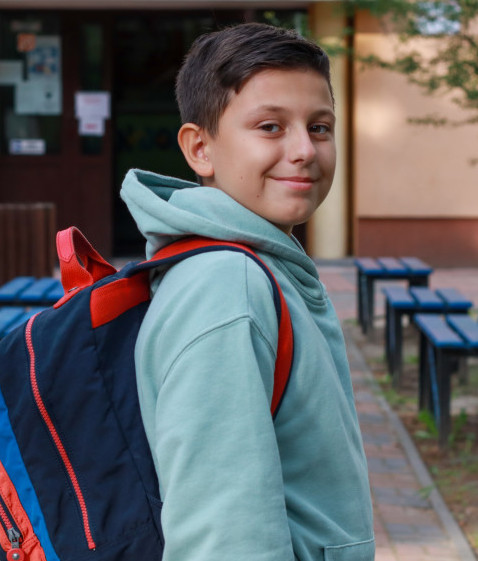By Maria Deniston, MS, OTR/L, Occupational Therapist and Jill Yochim, MA, Educational Specialist
 James, a middle-schooler, comes home from a long day at school and looks forward to downtime playing video games. After dinner, he searches for 15 minutes to find the scrap of paper where he wrote down his homework assignments, while his mother does the same, providing help that he does not appreciate.
James, a middle-schooler, comes home from a long day at school and looks forward to downtime playing video games. After dinner, he searches for 15 minutes to find the scrap of paper where he wrote down his homework assignments, while his mother does the same, providing help that he does not appreciate.
Upon finding the scribbled down assignment, three paragraphs on the night’s social studies reading, James shuts down.
He says it’s too much. For half an hour his mother cajoles him, trying to convince him that he can get it done while he argues back. Finally, she gives him an ultimatum–finish the work or no video games. Resentfully, James reads the social studies text for 15 minutes and writes three acceptable paragraphs in another 25 minutes. The assignment, which has created tension between them, took 40 minutes to complete. The evening’s entire homework saga, however, took nearly an hour and a half.
Cassie is a seven-year-old who can’t seem to get ready for school in the morning without constant nagging from her mother. Her mother has given her three things to take care of by herself: brushing her teeth, getting dressed and brushing her hair. Inevitably, when it is time to head out the door, none of the tasks have been completed and she is in her room mesmerized by one of her Barbies. Her mother is exasperated with telling her repeatedly to “Brush your teeth” or “Get dressed!” and tired of being rushed every morning. She finally brushes Cassie’s hair and dresses her because if she doesn’t they will be late. She can’t understand how Cassie gets distracted so easily or her daughter’s inability to accept the structure she tries to provide.
Disorganization and distraction go hand-in-hand
Disorganized or distracted behavior seems analogous with childhood. Children are known for getting distracted easily, especially when there is so much to lure their attention–music, TV, toys, their natural need to fidget, etc. But some kids struggle more than others. For those who struggle the most, distraction or disorganization can actually lead to a lifetime of perceived failure, lack of self-esteem and an inability to function in the world.
To avoid this, children need to develop a range of skills and habits that they may be missing in key areas, like planning and organization, time management, task initiation and impulse control. As children try to learn these skills and experience success, they are more likely to sense how their actions can have a positive impact on the world around them. If not, they may give up on wanting to try. With enough negative feedback, they may get overloaded and shut down.
How you can help
So how do you help the disorganized child develop skills and habits in these areas? Work on getting the habits to become automatic. Kids need lots of practice. Use structure to establish order. For some parents this is tricky. Perhaps, organization doesn’t come easily to you so you’re unsure how to begin. Or you are so organized you can’t understand how your child isn’t, and you tend to do things for him. Identify your own tendencies so you can better understand your child and your relationship. Structure may seem constraining, but within it is freedom.
Start with structure
Starting with a lot of structure and slowly pulling back over time will help your child develop the habits you want.
1. Make measurable attainable goals: Re-think your expectations and set short-term goals.
Children need to feel like they’re making progress. Break a task into smaller steps and take one task at a time. If you give your child too much to take on at once, he may feel overwhelmed and be unwilling to try. Remember to focus on small achievements and give credit when they are accomplished.
With a child like Cassie who has trouble getting out of the house in the morning, try breaking her tasks into smaller parts. See if she can complete one of the tasks, like brushing her teeth, without supervision for a few weeks before you introduce another one. Create a visual chart of what she must do. Or tape a picture of Cassie brushing her teeth to the inside of her door. When she wakes up in the morning, she sees the picture and is reminded of what she needs to do. Add tasks like brushing hair and getting dressed after brushing her teeth becomes a habit. Reduce your expectation from having her complete all of the tasks to mastering one task at a time, and she will have a greater likelihood of success.
2. Provide external structure: Give more help at first to establish the routine, and then take it away slowly over time.
If you provide motivation and positive reinforcement at the outset your child will develop new habits and routines in the long run.
For instance, try getting his backpack straightened with the acronym PACK: Purge, Accessorize, Categorize, and Keep It Up! (developed by Donna Goldberg in The Organized Student).
Reference PACK often and make sure he understands the steps:
- Help him purge what he doesn’t need. Provide leading questions so he comes to decisions on his own, such as “What do we do first?”
- Accessorize with pouches or cases that can hold small, miscellaneous items.
- Categorize papers and make compartments so that everything has a place. For younger kids, you can even take a picture of what is supposed to be inside the container and stick the picture to the exterior so he knows what goes inside.
- Keep following the practice every night (Keep It Up!). Eventually, he will develop the habit of going through his backpack on his own.
3. Engage your child in the process: Find the right motivator.
James’s parents sense his frustration and decide to talk with him about what they can change together. They empower him to control his schedule by giving him the freedom to choose how to spend his free time but developing parameters on how to earn it. They create a color-coded schedule with his school commitments in green, family in blue, and sports in orange so that James can visualize his scheduled and unscheduled time.
James’s motivation is all the unscheduled, white space that he sees after 7:00 PM. A color-coded schedule shows him his commitments and helps him understand that he has free time to look forward to once his obligations have been met.
4. Adapt his environment.
If your child needs stimulation to stay alert, provide alternative seating, like a ball chair, so he can wiggle around while he works.
Reduce visual distractions or create a special space just for homework. For the child who has trouble sitting still, give motor breaks. Physical activity is good–distracted kids need to release energy so they can try to focus calmly on their task. If something doesn’t work, try again and adapt it to fit with your child.
For an active, fidgety child, give him a break from sitting to run a few laps or ride his scooter. Exercise or heavy work can calm him so that he can focus on his schoolwork afterward. Set boundaries by suggesting a five-minute race outside on the condition that when you come in, it’s time to study. Keep trying new strategies . Sometimes a minor tweak can make the difference.
5. Look for small successes leading to big gains over time.
The goal for the disorganized child is to get him to self-monitor and to create the ability to complete what’s expected of him without even thinking about it. For organized adults, this comes easily because they’ve had years of experience or childhood training from a parent who provided structure and reinforcement. For children with a propensity for being disorganized and distracted, setting up an environment where small accomplishments are celebrated and skills are built over time can lead to a happy, confident child who grows into an independent, confident adult.
You too can feel confident that you have provided the tools necessary for your child’s success.







